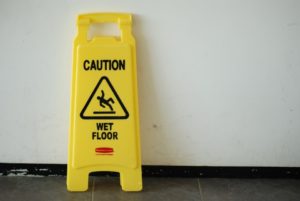 Slip and fall accidents are a form of premises liability.
Slip and fall accidents are a form of premises liability.
All premises liability lawsuits are litigated under the pretense that the owner or individual in control of the property should have anticipated that someone could be injured. Slip and fall accidents are no different.
Generally, slip and fall accident claims are filed either against a homeowner’s insurance policy or proprietor’s general liability coverage. Claims and lawsuits must be filed within three years of the date of the accident. But involving an attorney early in the process is the key to a successful outcome.
The expert premises liability lawyers at Sabbeth Law represent clients injured in slip and fall accidents. In this article, we’ll discuss how at-fault parties defend themselves from slip and fall litigation.
Blaming the Victim
As a matter of course, the liable party will blame you for your injuries in any slip and fall case. Why? Because the fact that you slipped and fell is not in doubt. The fact that you sustained injuries is not in doubt. What is in doubt is the extent to which your own actions contributed to your injuries. For that reason, the defendant and their insurance company will blame you for the accident.
Even if the at-fault party can say that you partly contributed to your own accident, they can reduce their liability under Vermont’s comparative negligence rule. This rule stipulates that a defendant is only responsible for their percentage of the blame. In other words, if you are 10% responsible for an accident, you can only recover 90% of your total damages.
Variations of this include:
- You were staring at your phone;
- You were behaving in a reckless manner;
- The dangerous condition was plainly obvious; or
- The dangerous area was cordoned off.
If your amount of the blame is determined to be 50% or higher, you will be barred from recovering damages for your injuries.
The Event was Not Foreseeable
Vermont has rules concerning when an injured party may recover damages against the individual in control of the premises. While the crux of the liability issue is foreseeability, slip and fall accidents generally fall into three categories:
- Cases in which the defendant knew about the dangerous condition;
- Cases in which the defendant caused the dangerous condition; and
- Cases in which the defendant should have known about the dangerous condition.
If a plaintiff can prove one of these elements, they have a successful slip and fall injury lawsuit on their hands.
Variations of this include:
- You were in an area that is restricted to the general public or where you were not expected;
- The proprietor did not have enough time to react to the dangerous condition; or
- The dangerous condition was an ‘Act of God’.
Talk to a Vermont Slip and Fall Accident Attorney
The attorneys at Sabbeth Law represent injured parties in slip and fall accidents. If your injuries were caused by a dangerous condition, you can recover damages given that certain conditions are met. Give us a call or contact us online and we can discuss the prospects of your lawsuit against an at-fault party.
